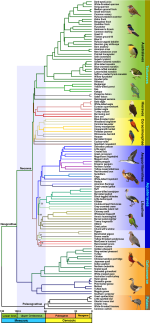Fred Ruhe
Well-known member

Shaoyuan Wu, Frank E. Rheindt, Jin Zhang Jiajia Wang, Lei Zhang, Cheng Quan , Zhiheng Li, Min Wang, Feixiang Wu,
Yanhua Qu, Scott V. Edwards, Zhonghe Zhou, and Liang Liu, 2024
Genomes, fossils, and the concurrent rise of modern birds and flowering plants in the Late Cretaceous
Proceedings of the National Academy of Sciences of the United States of America. 121 (8). e2319696121.
doi:10.1073/pnas.2319696121
Significance
Despite modern DNA advances, scientists still know little about how and when early bird groups evolved. Using new approaches to mine genomic information among 124 species covering most of modern bird diversity, we found that the main lineages of birds first divided into two groups: one mostly land-based and the other containing water-associated species. We demonstrate that modern birds date back further than previously assumed, much earlier than the dinosaurian extinction event, which seems to have had a limited impact on birds’ evolution. Instead, a warming event around ~55 Mya appears to have triggered the diversification of modern seabirds. Our study indicates that the radiation of modern birds was in remarkable lockstep with that of flowering plants and other organisms.
Abstract: https://www.pnas.org/doi/10.1073/pnas.2319696121
The phylogeny and divergence timing of the Neoavian radiation remain controversial despite recent progress. We analyzed the genomes of 124 species across all Neoavian orders, using data from 25,460 loci spanning four DNA classes, including 5,756 coding sequences, 12,449 conserved nonexonic elements, 4,871 introns, and 2,384 intergenic segments. We conducted a comprehensive sensitivity analysis to account for the heterogeneity across different DNA classes, leading to an optimal tree of Neoaves with high resolution. This phylogeny features a novel Neoavian dichotomy comprising two monophyletic clades: a previously recognized Telluraves (land birds) and a newly circumscribed Aquaterraves (waterbirds and relatives). Molecular dating analyses with 20 fossil calibrations indicate that the diversification of modern birds began in the Late Cretaceous and underwent a constant and steady radiation across the KPg boundary, concurrent with the rise of angiosperms as well as other major Cenozoic animal groups including placental and multituberculate mammals. The KPg catastrophe had a limited impact on avian evolution compared to the Paleocene–Eocene Thermal Maximum, which triggered a rapid diversification of seabirds. Our findings suggest that the evolution of modern birds followed a slow process of gradualism rather than a rapid process of punctuated equilibrium, with limited interruption by the KPg catastrophe. This study places bird evolution into a new context within vertebrates, with ramifications for the evolution of the Earth’s biota.
Enjoy,
Fred
Yanhua Qu, Scott V. Edwards, Zhonghe Zhou, and Liang Liu, 2024
Genomes, fossils, and the concurrent rise of modern birds and flowering plants in the Late Cretaceous
Proceedings of the National Academy of Sciences of the United States of America. 121 (8). e2319696121.
doi:10.1073/pnas.2319696121
Significance
Despite modern DNA advances, scientists still know little about how and when early bird groups evolved. Using new approaches to mine genomic information among 124 species covering most of modern bird diversity, we found that the main lineages of birds first divided into two groups: one mostly land-based and the other containing water-associated species. We demonstrate that modern birds date back further than previously assumed, much earlier than the dinosaurian extinction event, which seems to have had a limited impact on birds’ evolution. Instead, a warming event around ~55 Mya appears to have triggered the diversification of modern seabirds. Our study indicates that the radiation of modern birds was in remarkable lockstep with that of flowering plants and other organisms.
Abstract: https://www.pnas.org/doi/10.1073/pnas.2319696121
The phylogeny and divergence timing of the Neoavian radiation remain controversial despite recent progress. We analyzed the genomes of 124 species across all Neoavian orders, using data from 25,460 loci spanning four DNA classes, including 5,756 coding sequences, 12,449 conserved nonexonic elements, 4,871 introns, and 2,384 intergenic segments. We conducted a comprehensive sensitivity analysis to account for the heterogeneity across different DNA classes, leading to an optimal tree of Neoaves with high resolution. This phylogeny features a novel Neoavian dichotomy comprising two monophyletic clades: a previously recognized Telluraves (land birds) and a newly circumscribed Aquaterraves (waterbirds and relatives). Molecular dating analyses with 20 fossil calibrations indicate that the diversification of modern birds began in the Late Cretaceous and underwent a constant and steady radiation across the KPg boundary, concurrent with the rise of angiosperms as well as other major Cenozoic animal groups including placental and multituberculate mammals. The KPg catastrophe had a limited impact on avian evolution compared to the Paleocene–Eocene Thermal Maximum, which triggered a rapid diversification of seabirds. Our findings suggest that the evolution of modern birds followed a slow process of gradualism rather than a rapid process of punctuated equilibrium, with limited interruption by the KPg catastrophe. This study places bird evolution into a new context within vertebrates, with ramifications for the evolution of the Earth’s biota.
Enjoy,
Fred
Last edited:






